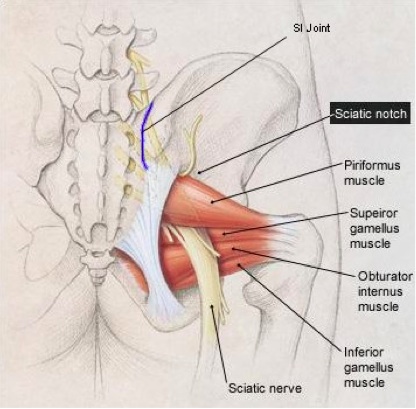Piriformis Syndrome
a frequent cause of sciatica symptoms
Piriformis Syndrome is a form of nerve entrapment, specifically sciatic nerve entrapment.
This is distinct from sciatic nerve compression which occurs in the lumbar spine at the nerve root and is often the result of a bulging or herniated disc. Nerve compression can result in true sciatica.
When the piriformis muscle becomes chronically tight, it can pinch or entrap the sciatic nerve which passes underneath it.
In a small percentage of the population, the sciatic nerve travels through, rather than underneath, the piriformis muscle. This portion of the populaton is at an even greater risk to suffer from piriformis syndrome.
(In an even smaller percentage of the population, the sciatic nerve travels over the top of the piriformis. These individuals would be unlikely to suffer from sciatic nerve entrapment, aka piriformis syndrome.)
Entrapment of the sciatica nerve by the piriformis muscle can result in pain in the buttocks that sometimes also travels down the leg.

Primary Causes of Piriformis Syndrome
The piriformis muscle can become chronically tight for numermous reasons:
Excessive Sitting (office, driving)
Excessive sitting can result in the hypercontraction of the hip flexor muscles, the psoas, iliacus, and rectus femoris muscles, in the front of the body. This can result in the inactivity of their antagonists, the gluteal muscles.
This occurs as a result of a neurological phenomenon called reciprocal inhibition. Weak or inactive gluteal muscles may cause the piriformis to compensate by tightening and shortening.
The problem may be helped by lengthening the hip flexors using a lunge stretch. Also, use of a kneeling chair drops the knees and allows the pelvis to shift forward. This takes the hip flexors out of a shortened position.
General Lack of Flexibility
Without regular exercise, or at least a routine of lower back stretches , the leg muscles, as well as all the muscles in the pelvis including the piriformis, can become tight and short.
Torsion in the Pelvis
Torsion in the pelvis, resulting in a functional leg-length discrepancy, can result in hypercontraction of the piriformis.
Correcting the problem requires a therapist versed in dealing with structural issues such as a Neuromuscular Therapist or a Rolfer.
In combination with with this type of soft-tissue therapist, a chiropractor may assist in improving pelvic torsion.
Scoliosis
If a curvature in the spine has caused a structural leg-length discrepancy, hypercontraction of the piriformis can result. Since structural scoliosis cannot be easily corrected, a lift in the shoe of the short leg may be required.
Overpronation of the Foot
Typically the result of a collapsed medial arch, overpronation of the foot results in the entire leg to be internally rotated. The piriformis, then, is put in a hyper-stretched or locked-long position.
In this case, and all cases where the piriformis is in a hyper-stretched position, stretching of the piriformis is NOT the answer, and will likely aggravate the muscle.
A simple strategy to alleviate overpronation is a to use arch supports such a SuperFeet.
Wallet in the Back Pocket
Known as “fat wallet syndrome”, “wallet sciatica”, and other names, a big thick wallet housed in a back pocket will press directly onto the piriformis muscle, especially when sitting.
I’ve had numerous clients over the years achieve immediate and lasting relief for “that pain in the butt” by simply finding a new home for their wallet.
Sacroiliac Joint Dysfunction
The sacroiliac joint is where the pelvis joins with the sacrum. The muscle attachment of the piriformis, on the front edge of the sacrum, is just below the sacroiliac joint.
Therefore, if the SI joint is either hypomobile (stuck) or hypermobile (too loose), the state of piriformis can be impacted.
Return to Top | Causes Index | Home Page
Anatomy Images Courtesy of BIODIGITAL
Stephen O'Dwyer, cnmt
Neuromuscular Therapist & Pain Relief Researcher
FOUNDERLower Back Pain Answers |

|
CURRENT COURSES POSTURAL BLUEPRINT FOR CORRECTING PELVIC TORSION: The Complete Guide To Restoring Pelvic Balance (2022) STRETCHING BLUEPRINT FOR PAIN RELIEF & BETTER FLEXIBILITY: The Complete Guide to Pain-Free Muscles Using Active Isolated Stretching (2020) HEALING THE HIDDEN ROOT OF PAIN: Self-Treatment for Iliopsoas Syndrome (2013) FREE MINI COURSE: Introduction to Active Isolated Stretching |
